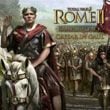Battles | General tips
Battles in Rome II: Caesar in Gaul are nearly no different than in the base game. The essential change is a limited units selection: you will encounter no war chariots, battle elephants or exotic mounted archers. The most common sight in Gaul are fighting hordes of lightly armoured barbarians accompanied by ranged troops and cavalry. Only the Roman troops seem to break out from that rule, because of the legionaries, who are the most elite troops available in the campaign.
Barbarians

Since the Celts and the Germans are not as well-trained as the Romans, their lacks have to be made up for in numbers. The core of a barbaric army should consist of numerous infantry troops and ranged units stationed behind them - this part of an army may be compared to a hard place, which has to face all the enemy forces. The rock in this case is cavalry and elite infantry, such as berserkers. The tactics is very simple: the infantry forms a wide line and starts walking toward the enemy. You should see to it that each of your units engages only one enemy unit. Now, the cavalry is brought into action - they momentarily crush the withdrawn archers and prepare for a charge on the backs of the enemy infantry. Using all special abilities and then charging on the enemies should prove devastating for them. A well-performed rock and a hard place manoeuvre should make it possible to destroy any enemy army with minimal losses on your side.

Problems start when it comes to sieges, where your cavalry loses its effectiveness. As much as it is possible you should use delaying tactics - keep the siege until the enemy is starved and forced to step into foregrounds. If, however, you cannot afford to waste time, you will first have to perform a long and toilsome bombardment on the enemy fortifications and troops. The more damage your archers and siege engines can cause, the less losses your infantry will suffer. During sieges your cavalry should look for alleys between buildings, so to get at the enemy's back.
Rome

First Roman armies are consisted of a mixture of the Celts and the Romans. This is why a small number of legionaries should make the core of an army, while light armoured barbaric troops take care of flanking enemy forces. As far as it is possible you should also have a couple of cavalry troops, which would be able to strike the enemy at the back. At this point you may easily make use of the tactics described in the previous chapter.
As the game progresses, you will slowly replace the barbarians in your army with legionaries. Once the ratio is conversed you will notice that, your infantry troops are able to defeat enemies without the help from cavalry - Roman "war machine" will be able to crash through any Gaelic army. Of course you still need to keep your flanks and back secure, but at the same time, while commanding legionaries, you have a significant margin of error.
Roman superiority over barbarians is evident during sieges. Well-trained, well-equipped and well-armoured heavy infantry is excellent in narrow streets of cities and towns, where it cannot be flanked and the enemy has no way of using their numerical advantage. It is just enough to slowly push the enemy toward the centre and occasionally call back injured units to replace them with fresh ones.
Ambush

Because of the large number of factions and the aggressive AI, at many occasions you will be able to attack enemy troops while they are marching. During this type of battles the defenders are arranged in row, whereas you may place your troops just in range for a charge. To achieve the best possible effect, I recommend the following positioning:
- At east 3-4 elite units should be placed near the enemy general. The sooner you kill him, the sooner the enemy army starts panicking.
- Enemy heavy infantry should be tied up in combat with your own infantry. It is best to put 2 units up against 3 enemy units - this way you will prevent the enemy troops from moving.
- Enemy cavalry should be best tied up with spearmen. In this case, you just need to keep the enemy busy, not necessarily annihilate them instantly.
- Your own cavalry should be placed against enemy archers. Its goal is to eliminate the enemy infantry with one strike.
The rest of the battle depends on managing the cavalry properly. With just a little bit of practice you will be able to destroy the enemy general unit and archers as well as block heavy infantry and cavalry with the first strike. Having done that you should move the cavalry at the backs of enemies engaged in combat and charge at them - preferably using numerical advantage (i.e. sending 3 cavalry units at 2 enemy infantry units)
A well-performed ambush is likely to destroy an entire enemy army with minimal losses on your side.
You are not permitted to copy any image, text or info from this page. This site is not associated with and/or endorsed by the SEGA or Creative Assembly. All logos and images are copyrighted by their respective owners.
Copyright © 2000 - 2025 Webedia Polska SA for gamepressure.com, unofficial game guides, walkthroughs, secrets, game tips, maps & strategies for top games.
